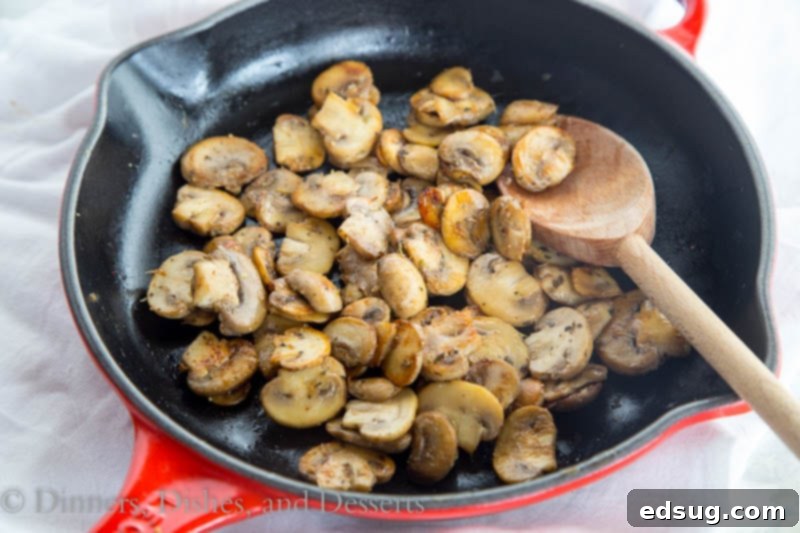Master the Art of Sautéing Mushrooms: Easy Recipe & Expert Tips for Perfectly Cooked Fungi
Mushrooms are truly a versatile culinary delight, and learning how to cook them properly can elevate countless dishes. This guide focuses on creating the most delicious, quick, and easy sautéed mushrooms – a fundamental skill that every home cook should master. Whether you’re looking for the ideal accompaniment to a sizzling steak, a savory base for a rich gravy, or a simple yet flavorful side dish, these perfectly golden-brown fungi will not disappoint.
I find myself reaching for mushrooms almost daily. Whenever we prepare a juicy steak, a batch of these easy sautéed mushrooms is almost always on the menu. They add a depth of flavor and a wonderful texture that complements the meat beautifully. But don’t limit them to just steak! They are equally delightful enjoyed on their own as a light and healthy treat.
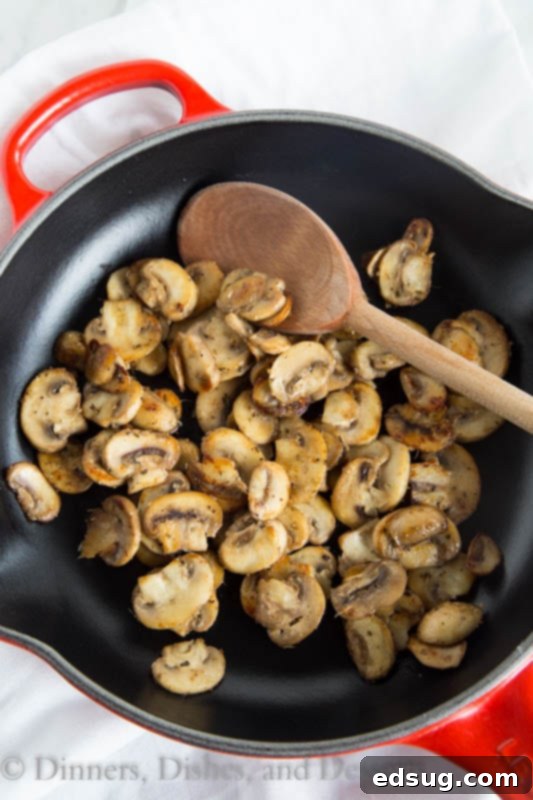
Beyond being a fantastic topping, sautéed mushrooms form the flavorful foundation for many other recipes. For instance, my popular smothered pork chops begin with these very mushrooms, which create a rich and savory sauce. Mastering the simple technique of how to cook mushrooms opens up a world of culinary possibilities, making it an invaluable skill in your kitchen repertoire.
Why Sautéing is the Best Way to Cook Mushrooms
Sautéing is arguably the most popular and effective method for cooking mushrooms, and for good reason. This high-heat cooking technique, typically done in a shallow pan with a small amount of fat, allows the mushrooms to develop a beautiful golden-brown crust and a concentrated, earthy flavor. Unlike boiling or steaming, which can leave mushrooms watery and bland, sautéing encourages the natural sugars to caramelize, resulting in a deeper, more satisfying taste and a tender-chewy texture. It’s a quick process that transforms simple fungi into a gourmet addition to any dish.
The Health Benefits of Mushrooms
Not only are mushrooms incredibly delicious, but they also pack a nutritional punch! They are low in calories and fat, yet rich in essential vitamins and minerals. Mushrooms are an excellent source of B vitamins (riboflavin, niacin, pantothenic acid), which are crucial for energy production and nerve function. They also provide selenium, an important antioxidant, and potassium, vital for heart health. Some varieties, especially those exposed to UV light, are even a good source of Vitamin D. Incorporating mushrooms into your diet is a flavorful way to boost your nutrient intake and enjoy their unique umami flavor.
Essential Ingredients for Perfect Sautéed Mushrooms
For detailed measurements and the full recipe, scroll to the bottom of the post for the PRINTABLE recipe card.
- Mushrooms: The star of our dish! This method is incredibly versatile and works wonderfully with various types. Common choices include classic white button mushrooms, more flavorful cremini (also known as baby bella) mushrooms, or even a mix of gourmet varieties. Feel free to experiment with what you love!
- Olive Oil: Used for its higher smoke point, olive oil helps achieve that desirable sear on the mushrooms without burning. It contributes to their golden-brown exterior and adds a subtle fruity note.
- Butter: The addition of butter is key for richness and a beautiful browned finish. Butter adds a creamy, nutty depth of flavor that complements the earthiness of the mushrooms perfectly.
- Salt & Pepper: Simple yet essential seasonings that enhance the mushrooms’ natural taste. The timing of when to add salt is crucial, as you’ll discover in our steps.
- Seasonings: This is where you can truly personalize your dish. I often opt for minced garlic for a classic savory touch and a hint of Italian seasoning for an aromatic boost. However, don’t hesitate to get creative with fresh herbs like thyme or rosemary, or your favorite spice blends.
Mastering the Art of Sautéing Mushrooms: A Step-by-Step Guide
- Proper Mushroom Preparation (To Wash or Not to Wash?): This is a common point of discussion among chefs! Some argue that mushrooms absorb water like sponges, leading to soggy results if rinsed. Others say a quick wash is fine. Personally, I haven’t noticed a significant difference in the final product when sautéing. My method: I keep the water on a very gentle trickle and quickly brush away any dirt under the running water. Alternatively, you can simply use a damp cloth or a soft mushroom brush to gently clean them without excessive moisture. The goal is to remove dirt, not to soak them.
- Choose the Right Pan – Size Matters: To achieve beautifully seared mushrooms instead of steamed ones, a large skillet is crucial. You want ample surface area so that the mushrooms can spread out in a single layer. This ensures that as many mushrooms as possible come into direct contact with the hot pan and the cooking fat, allowing them to brown and develop that irresistible texture and flavor. An overcrowded pan will trap moisture, causing the mushrooms to steam and become soft, rather than crisp and golden.
- Uniform Slicing for Even Cooking: Once cleaned, thinly slice your mushrooms to a consistent thickness. This step is vital for even cooking. If some slices are thick and others thin, you’ll end up with a mix of perfectly cooked, undercooked, and potentially burnt pieces. Aim for uniform slices, generally about 1/4 inch thick, so they all cook at the same rate and reach that perfect tender-crisp stage simultaneously.
- The Perfect Fat Blend: Olive Oil and Butter: For the best flavor and browning, I highly recommend using a combination of olive oil and butter. Olive oil has a higher smoke point, which helps prevent the butter from burning too quickly and provides a good base for searing. Butter, on the other hand, adds unparalleled richness, a beautiful golden color, and a nutty flavor that is simply divine with mushrooms. Heat both in your large skillet over medium-high heat until the butter is melted and sizzling, but not browned.
- Resist the Urge to Stir: Let Them Sear! This might sound counter-intuitive, but it’s one of the most important tips for great sautéed mushrooms. Once the mushrooms are in the hot pan, spread them out into an even layer and *leave them alone* for the initial few minutes. Avoid stirring them too often. This allows the pan and the hot fat to work their magic, creating a beautiful caramelized crust on one side. If you constantly stir, the mushrooms will release their moisture too quickly and won’t have a chance to sear, leading to a steamed result. Let them sit undisturbed for about 5 minutes, then give them a good stir and continue cooking for another 4-5 minutes, or until they are tender and golden brown all over.
- Season at the End for Best Texture: Timing your seasoning is key. It’s best to add salt and pepper towards the end of the cooking process, after the mushrooms have mostly browned. Salt draws out moisture from food, and if added too early, it can cause the mushrooms to release their liquid prematurely, hindering the browning process and potentially making them soggy. Once they’ve achieved that desirable golden hue and tender texture, then season them to taste with salt, pepper, and any other desired herbs or spices.
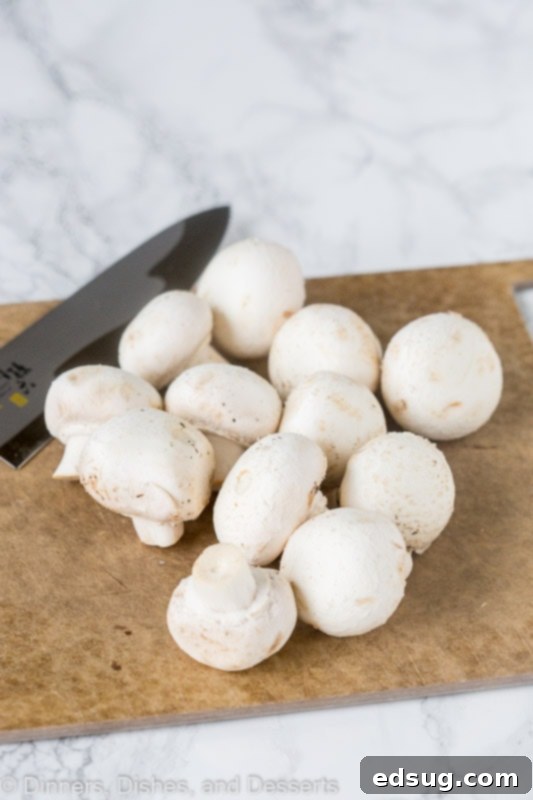
Achieving the Best Sautéed Mushrooms
For me, the pinnacle of mushroom perfection lies in a good sear. This is why having enough space in your skillet is non-negotiable – it allows the mushrooms to properly spread out and directly contact the heat, promoting caramelization. While mushrooms are perfectly safe to eat raw, that slight char developed during sautéing unlocks an incredible depth of flavor and a more pleasing texture. Once you grasp these fundamental sautéing principles, you’ll consistently create incredibly flavorful mushrooms.
Beyond the basics, feel free to customize the flavors. I typically season my sautéed mushrooms with a touch of minced garlic and a sprinkle of Italian seasoning. This combination provides a rich, aromatic profile that enhances their natural earthiness without being overpowering. However, your kitchen, your rules! Don’t hesitate to experiment with fresh thyme, rosemary, a splash of balsamic vinegar, or even a dash of soy sauce for an umami kick. The possibilities are endless.
Choosing the Right Mushrooms for Sautéing
One of the beauties of this sautéing method is its adaptability. You can truly use almost any type of mushroom you prefer, and the technique will yield fantastic results. In the pictures accompanying this recipe, I’ve used common white button mushrooms, which are readily available and affordable for everyone. They have a mild flavor that absorbs other seasonings well. However, for a slightly deeper, more robust flavor and a firmer texture, I often gravitate towards baby bella mushrooms (also known as cremini mushrooms). Their earthier notes add another layer of complexity to the dish.
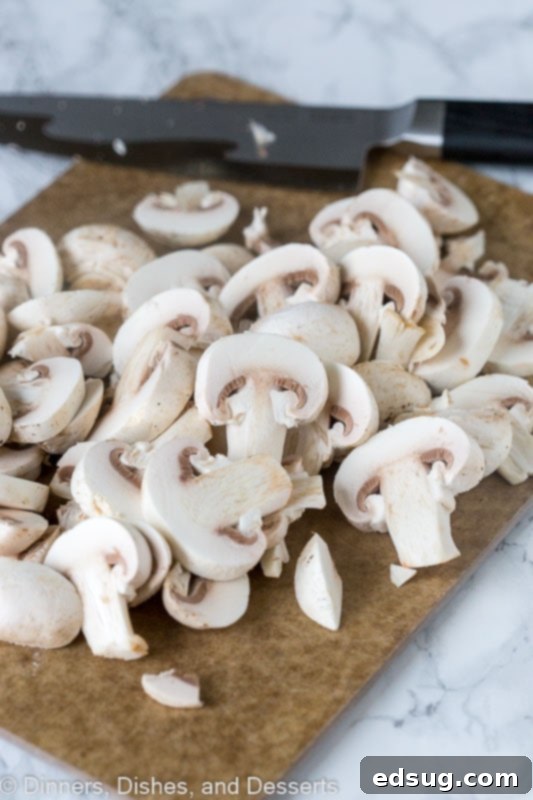
Beyond these common varieties, feel free to explore! Sliced shiitake mushrooms bring a more intense, woodsy flavor, while oyster mushrooms offer a delicate, slightly peppery taste and a beautiful, frilly texture. The key is to slice them uniformly, regardless of the variety, to ensure they cook evenly. Once you’ve mastered the basic sautéing technique, you’ll find that most other mushroom recipes, from complex gravies to simple pasta dishes like Skillet Beef Stroganoff, begin with this essential step.
Common Mistakes to Avoid When Cooking Mushrooms
- Overcrowding the Pan: As mentioned, this is the biggest culprit for soggy mushrooms. Cook in batches if necessary, giving each mushroom space to breathe and sear.
- Adding Salt Too Early: This draws out moisture, preventing browning. Wait until they’re nearly cooked before seasoning with salt.
- Using Too Little Fat: Fat is essential for browning and flavor. Don’t be shy with the olive oil and butter.
- Cooking on Too Low Heat: Medium-high heat is necessary for searing. Too low, and they’ll steam rather than brown.
- Not Cleaning Properly: While avoiding soaking is important, you still need to remove dirt and grit.
Serving Suggestions & Flavor Variations
These versatile sautéed mushrooms can elevate almost any meal. Serve them piled high on your favorite steak, grilled chicken, or pork chops. Stir them into scrambled eggs or omelets for a decadent breakfast. They make a fantastic addition to pasta dishes, grain bowls, or as a flavorful topping for burgers and sandwiches. Don’t forget their potential as a base for creamy sauces and gravies!
To vary the flavor, consider:
- Herbs: Fresh thyme, rosemary, or parsley added towards the end.
- Garlic & Onion: Sauté minced garlic or finely chopped shallots with the mushrooms.
- Heat: A pinch of red pepper flakes for a subtle kick.
- Umami Boost: A splash of soy sauce or Worcestershire sauce.
- Tang: A teaspoon of balsamic vinegar or lemon juice at the very end.
Storage and Reheating Tips
If you happen to have any leftover sautéed mushrooms (a rare occurrence!), they store well in an airtight container in the refrigerator for 3-4 days. To reheat, gently warm them in a skillet over medium heat with a tiny bit of butter or olive oil until heated through. Be careful not to overcook them, or they can become rubbery.
In case you couldn’t tell, I absolutely adore mushrooms. My family might not be as enthusiastic, but that certainly doesn’t deter me! I will continue to prepare and enjoy them as often as I possibly can.
Still feeling a little intimidated, or looking for an alternative cooking method? Give Air Fryer Mushrooms a try for a wonderfully quick and easy version that requires almost no hands-on effort!
More Delicious Mushroom Recipes to Explore
- Hamburger Steaks with Mushroom Gravy
- Creamy Mushroom Soup
- Tuscan Chicken Pasta
- Creamy Mushroom Pasta
- Creamy Chicken and Rice
- Ground Beef Stroganoff
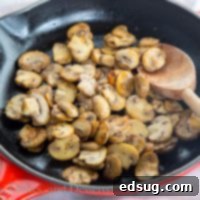
How to Cook Mushrooms
Pin Recipe
Rate Recipe
Print Recipe
Ingredients
- 1 package, 8 oz mushrooms, thinly sliced
- 2 teaspoons butter
- 1 teaspoons olive oil
- 1 clove garlic, minced
- 1/2 teaspoon Italian seasoning
- 1/2 teaspoon salt
- 1/4 teaspoon black pepper
Instructions
-
Heat butter and olive oil in a large skillet over medium-high heat.
-
Add mushrooms to the pan, spreading into a single layer. Let cook for 5 minutes before stirring.
-
Stir and cook for 4-5 more minutes until the mushrooms are tender and starting to turn golden brown.
-
Add garlic to the pan and cook for 2-3 minutes, stirring occasionally, until fragrant.
-
Season with Italian seasoning, salt, and pepper. Stir well and serve immediately.
Nutrition
Nutrition information is automatically calculated, so should only be used as an approximation.
Additional Info
Like this recipe? Leave a comment below!
I’ve created a fun and engaging group on Facebook, and I’d absolutely love for you to join us! It’s a vibrant community where you can share your favorite recipes, ask questions, get cooking inspiration, and stay updated on all the exciting new recipes from Dinners, Dishes and Desserts (so you never miss out!).
Be sure to follow me on Instagram and tag #dinnersdishes so I can see all the wonderful DINNERS, DISHES, AND DESSERTS recipes YOU create!
Don’t forget to follow me on my social media channels to ensure you never miss a new post or recipe!
Facebook | Twitter | Pinterest | Instagram
